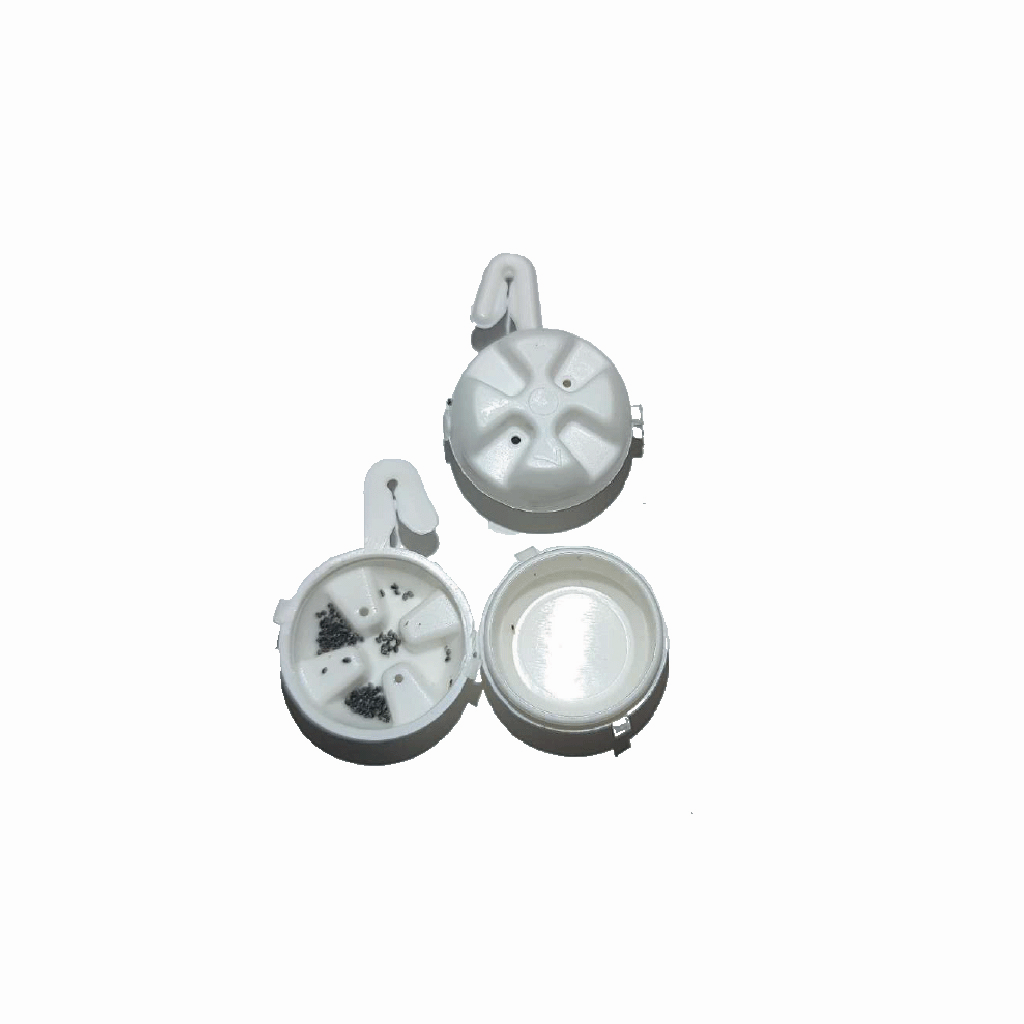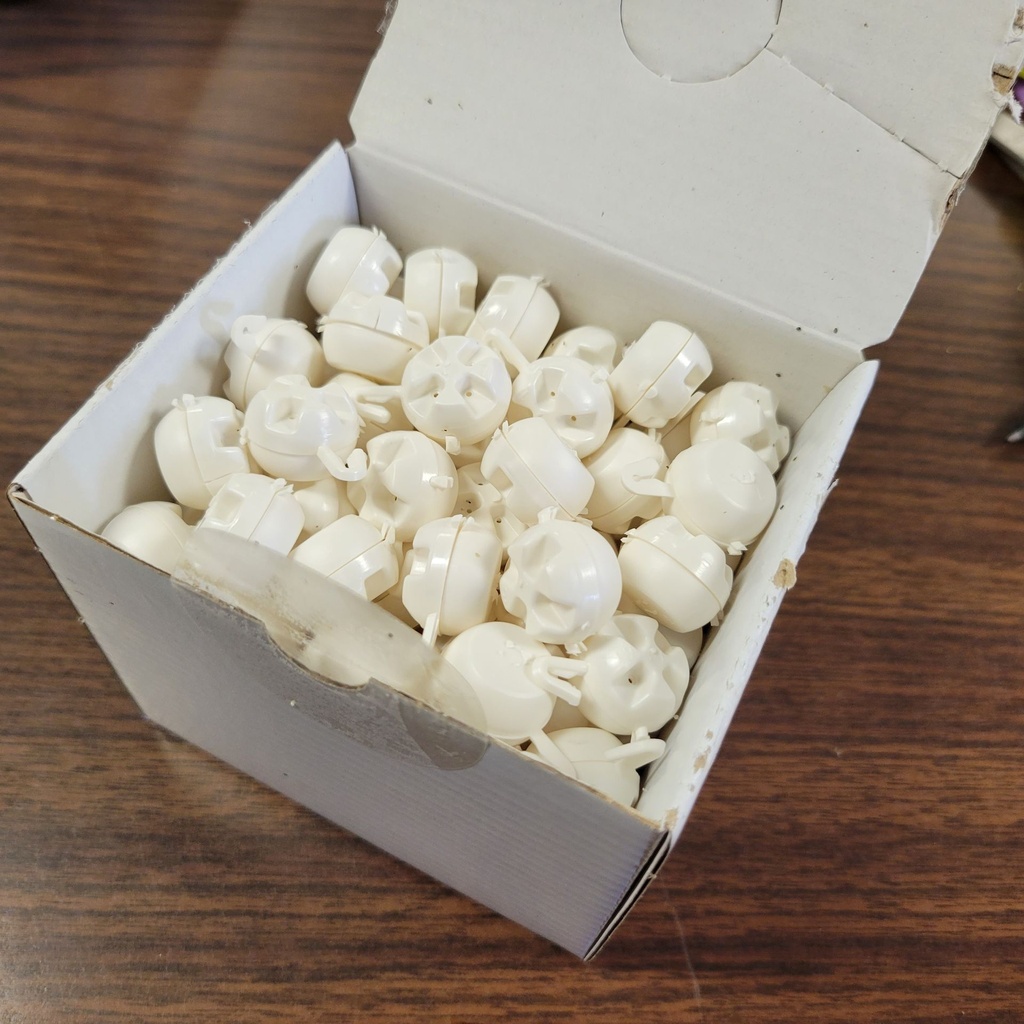BioBee BioEncarsia/Eretmocerus pods - Encarsia formosa / Eretmocerus eremicus mummies mix (120 pods of 125, total 15,000 mummies / box)
130-110-03-125972251
- GHL_BioBee_Pods-Compostable-Certificate_EN_V2022-11-07.pdf
- GHL-Tableau-taux-application-auxiliaires-BioBee-V2024-04-09.pdf
- GHL_BioBee_BioEretmocerus-product-page_V2022-08-24.pdf
- GHL_BioBee_BioEncarsia-Product-page_V2022-08-24.pdf
- GHL_BioBee_Beneficials-and-target-pests-chart_V2022.jpg
- GHL_BioBee_BIOBEE DISPENSER PODS_V2023-03-14.pdf
Availability:
backordered
Shipping time if backordered::
jusqu'à 2 semaines
In case of backorder::
Only replenished IF YOU ORDER IT
MAIN TARGETS
Greenhouse whitefly (Trialeurodes vaporariorum) and Sweetpotato whitefly (Bemisia tabaci).
ADDITIONAL TARGETS
-
TIPS
lt's important to identify species of whitefly in your crop. Use before whiteflies build up in the crop or else in conjunction with other bio-control agents.
PRODUCT DESCRIPTION & PACKAGING
Encarsia formosa:
BioEncarsia (Encarsia formosa) is a parasitic wasp of the Aphelinidae family. E. formosa can utilize at least 15 species of whitefly as hosts but the principal host is the greenhouse whitely.
The tiny females are black with a yellow abdomen and opalescent wings while the males (although rare) are completely black in color. BioEncarsia should only be applied when temperatures range between 20-30°C.
Parasitized greenhouse whitefly pupae turn black in about 10 days and are easily distinguished from non-parasitized hosts.
An effective parasite of the greenhouse whitefly, these tiny wasps are shipped as 'mummies.' These emerging black and yellow wasps search for immature whiteflies to parasitize. BioEncarsia provides a solution for greenhouse whitefly control in greenhouses nurseries, on crops including, strawberries, cucumbers, tomatoes and ornamentals.
BioEncarsia is available in different forms:
- Cardboard strips with mummified whitefly eggs.
- Biodegradable pods with mummified whitefly eggs.
- Bottle of 5,000 mummies in a sawdust medium.
Eretmocerus eremicus:
BioEretmocerus (Eretmocerus eremicus) is a parasitic wasp used for the control of sweet potato whitefly and greenhouse whitely.
Adult females are very small (1mm) and light yellow in color while males are darker. E. eremicus parasitize and feed on whitely larvae .
An effective parasitic wasp of silverleaf/sweetpotato whitefly. These tiny yellow wasps are shipped as 'mummies' which are placed in the crop. The emerging wasps search for immature whiteflies on which to insert their eggs.
BioEretmocerus provides a solution for whitefly control in greenhouses nurseries, on crops including ornamentals, strawberries, cucumbers and tomatoes.
BioEretmocerus is available in cards containing parasitized “mummies” or in biodegradable pods.
STORAGE
- Storage temperature: 8-10°C (46-50°F)
- Do not store in sunlight
- Apply within 24 hours
APPLICATION
BioEncarsia/Eretmocerus is shipped in insulated, chilled boxes. Packaging must be kept intact until placed in the field.
- Apply within 24 hours of receipt.
- Keep in a cool location until release.
- Distribute by hanging the containers with pupae in the crop, on the plants.
- Do not expose the bottles to direct sunlight.
To apply BioEncarsia/Eretmocerus as pods:
- Hang the pods among the crop about 4 leaves below the top of the plant.
- Or place the pods on the soil, near the plant.
- Make sure the pods are not in direct sunlight.
The amount and frequency of the application (introduction rate) is determined by the target crop, level of infestation, weather conditions and damage inflicted to the crop.
DISCLAMER
Before combining this product with any chemical pesticide in the crop, please consult your BioBee technical field representative.
BioBee Sde Eliyahu Ltd. produces and markets biological products. Production is carried out using innovative techniques under controlled quality assurance standards such as ISO 9001:2015, as well as IOBC’s international standards for mass-production of insects. All products are tested to meet specification requirements before leaving the factory.
The success of biological pest control is affected by the crop’s initial pest population (upon application of the product), weather conditions and chemical residue present in the crop, among other possible aggravating factors.
Under no circumstance shall BioBee or Groupe Horticole Ledoux inc. be liable for the outcome of the implementation in the field, as it has no control over local conditions, the application method, or the possible improper treatment/storage of the product.
Specifications
| Instruction / | delivery |
MAIN TARGETS
Greenhouse whitefly (Trialeurodes vaporariorum) and Sweetpotato whitefly (Bemisia tabaci).
ADDITIONAL TARGETS
-
TIPS
lt's important to identify species of whitefly in your crop. Use before whiteflies build up in the crop or else in conjunction with other bio-control agents.
PRODUCT DESCRIPTION & PACKAGING
Encarsia formosa:
BioEncarsia (Encarsia formosa) is a parasitic wasp of the Aphelinidae family. E. formosa can utilize at least 15 species of whitefly as hosts but the principal host is the greenhouse whitely.
The tiny females are black with a yellow abdomen and opalescent wings while the males (although rare) are completely black in color. BioEncarsia should only be applied when temperatures range between 20-30°C.
Parasitized greenhouse whitefly pupae turn black in about 10 days and are easily distinguished from non-parasitized hosts.
An effective parasite of the greenhouse whitefly, these tiny wasps are shipped as 'mummies.' These emerging black and yellow wasps search for immature whiteflies to parasitize. BioEncarsia provides a solution for greenhouse whitefly control in greenhouses nurseries, on crops including, strawberries, cucumbers, tomatoes and ornamentals.
BioEncarsia is available in different forms:
- Cardboard strips with mummified whitefly eggs.
- Biodegradable pods with mummified whitefly eggs.
- Bottle of 5,000 mummies in a sawdust medium.
Eretmocerus eremicus:
BioEretmocerus (Eretmocerus eremicus) is a parasitic wasp used for the control of sweet potato whitefly and greenhouse whitely.
Adult females are very small (1mm) and light yellow in color while males are darker. E. eremicus parasitize and feed on whitely larvae .
An effective parasitic wasp of silverleaf/sweetpotato whitefly. These tiny yellow wasps are shipped as 'mummies' which are placed in the crop. The emerging wasps search for immature whiteflies on which to insert their eggs.
BioEretmocerus provides a solution for whitefly control in greenhouses nurseries, on crops including ornamentals, strawberries, cucumbers and tomatoes.
BioEretmocerus is available in cards containing parasitized “mummies” or in biodegradable pods.
STORAGE
- Storage temperature: 8-10°C (46-50°F)
- Do not store in sunlight
- Apply within 24 hours
APPLICATION
BioEncarsia/Eretmocerus is shipped in insulated, chilled boxes. Packaging must be kept intact until placed in the field.
- Apply within 24 hours of receipt.
- Keep in a cool location until release.
- Distribute by hanging the containers with pupae in the crop, on the plants.
- Do not expose the bottles to direct sunlight.
To apply BioEncarsia/Eretmocerus as pods:
- Hang the pods among the crop about 4 leaves below the top of the plant.
- Or place the pods on the soil, near the plant.
- Make sure the pods are not in direct sunlight.
The amount and frequency of the application (introduction rate) is determined by the target crop, level of infestation, weather conditions and damage inflicted to the crop.
DISCLAMER
Before combining this product with any chemical pesticide in the crop, please consult your BioBee technical field representative.
BioBee Sde Eliyahu Ltd. produces and markets biological products. Production is carried out using innovative techniques under controlled quality assurance standards such as ISO 9001:2015, as well as IOBC’s international standards for mass-production of insects. All products are tested to meet specification requirements before leaving the factory.
The success of biological pest control is affected by the crop’s initial pest population (upon application of the product), weather conditions and chemical residue present in the crop, among other possible aggravating factors.
Under no circumstance shall BioBee or Groupe Horticole Ledoux inc. be liable for the outcome of the implementation in the field, as it has no control over local conditions, the application method, or the possible improper treatment/storage of the product.
| Order-driven inventory |


















![[130-110-03-125025500] BioBee BioEncarsia - Encarsia formosa mummies (5,000 / bottle)](/web/image/product.product/25068/image_128/%5B130-110-03-125025500%5D%20BioBee%20BioEncarsia%20-%20Encarsia%20formosa%20mummies%20%285%2C000%20-%20bottle%29?unique=e8865b4)
![[130-110-03-125994150] BioBee BioEncarsia pods - Encarsia formosa mummies (120 pods of 125, total 15,000 mummies / box)](/web/image/product.product/24927/image_128/%5B130-110-03-125994150%5D%20BioBee%20BioEncarsia%20pods%20-%20Encarsia%20formosa%20mummies%20%28120%20pods%20of%20125%2C%20total%2015%2C000%20mummies%20-%20box%29?unique=e8865b4)
![[130-110-03-126994150] BioBee BioEretmocerus pods - Eretmocerus eremicus mummies (120 pods of 125, total 15,000 mummies / box)](/web/image/product.product/24930/image_128/%5B130-110-03-126994150%5D%20BioBee%20BioEretmocerus%20pods%20-%20Eretmocerus%20eremicus%20mummies%20%28120%20pods%20of%20125%2C%20total%2015%2C000%20mummies%20-%20box%29?unique=e8865b4)